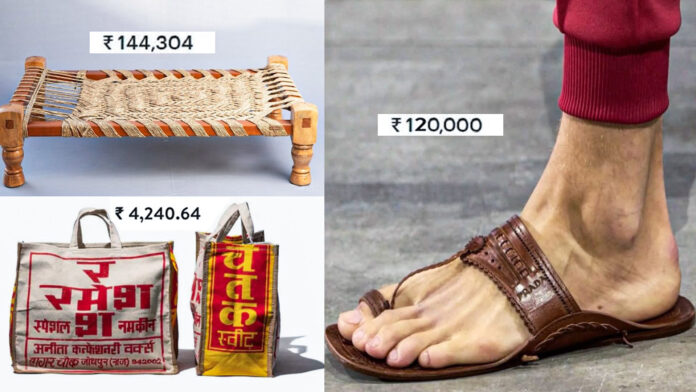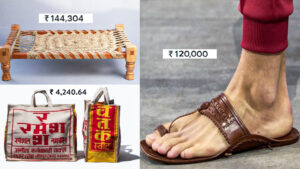
1. Prada Sells Kolhapuri Chappals for more than ₹1,00,000: Fashion Statement or Cultural Copy?
The fusion of luxury fashion and traditional craftsmanship has always been fascinating—and sometimes controversial. One recent example? Italian fashion house Prada has launched a sandal that bears a striking resemblance to India’s traditional Kolhapuri Chappal, priced at a jaw-dropping around ₹1,00,000.
What Are Kolhapuri Chappals?
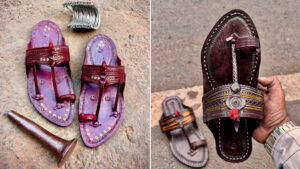
Kolhapuri chappals are handcrafted leather sandals from Kolhapur, Maharashtra. With their flat sole, intricate design, and sturdy make, they’ve been a symbol of Indian heritage for centuries. These chappals are typically made by skilled local artisans, often costing anywhere between ₹500 to ₹2,000 in Indian markets.
What’s Prada Selling?
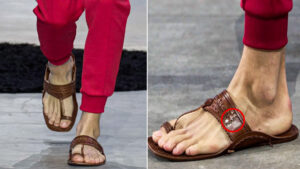
Prada’s version of the Kolhapuri sandal, part of its luxury footwear collection, features:
Tan leather straps
A classic open-toe design
A sleek, minimalist finish
Price: around ₹1,00,000
While they exude sophistication, the resemblance to traditional Kolhapuris is unmistakable.
The Backlash: Appreciation or Appropriation?
The launch has sparked mixed reactions:
✅ Appreciation: Some fashion enthusiasts applaud Prada for bringing Indian-inspired designs to the global runway. It shows the timeless appeal of Indian craftsmanship.
❌ Appropriation: Others criticize the brand for:
Not crediting Indian artisans
Not collaborating with local craftsmen
Selling a traditional Indian product at an inflated “luxury” price
Many question why something rooted in Indian heritage, available locally for a fraction of the price, is now being sold as a luxury statement without any reference to its origin.
What Could Have Been Done Better?
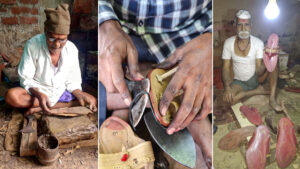
Imagine if Prada had:
Collaborated with artisans from Kolhapur
Highlighted the cultural history behind the sandal
Shared profits or offered support to Indian shoemakers
Such a move could have set a new standard in ethical fashion.
Final Thoughts: A Lesson in Global Fashion Ethics
Prada’s ₹75,000 Kolhapuri-style sandals are a classic example of fashion’s ongoing dilemma: where does inspiration end and imitation begin?
As global brands continue to dip into Indian heritage for design inspiration, there is a growing call to ensure that recognition, respect, and revenue are given back to the communities keeping these traditions alive.
2. Puebco’s Indian Souvenir Bag: When Global Brands Sell Local Culture
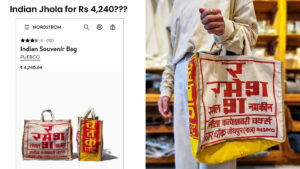
In the age of globalisation, the lines between cultures are blurring — especially in fashion and home design. One of the most recent examples is Japanese lifestyle brand Puebco, which is now offering an “Indian Souvenir Bag” — a product clearly inspired by the traditional Indian jhola or cloth bag. But is this a case of appreciation or appropriation?
Let’s explore how Puebco is marketing this Indian-style bag, how much it costs, and why this trend of global brands rebranding Indian street-style accessories is both fascinating and controversial.
👜 What Is the Indian Souvenir Bag?
Puebco’s Indian Souvenir Bag is a rugged, unstructured cotton tote, made from recycled textile scraps, featuring bright prints and stitching reminiscent of handmade Indian bags found in local markets.
Each bag is labeled “Made in India” — a nod to its origin, but with a minimal, curated aesthetic often associated with Japanese brands. The bag design is unmistakably inspired by the everyday jhola carried by students, artists, and shoppers across India.
💸 How Much Does It Cost?
Here’s the part that raises eyebrows.
Puebco’s Indian Souvenir Bag sells for around $40–$50 (₹3,500 to ₹4,000) depending on the region and retailer.
Compare this to the original Indian counterpart, which you can buy from local bazaars for as low as ₹100–₹300.
It’s not the first time a global brand has upcycled or repackaged traditional Indian designs at a premium price. The key question is — are they giving back to the communities or artisans who created the original design?
🌍 Cultural Inspiration or Commodification?
International brands like Puebco, Urban Outfitters, and even Prada have been known to borrow heavily from Indian aesthetics — from charpoys to Kolhapuri chappals. While some celebrate this global appreciation for Indian crafts, others raise concerns:
Is the original cultural meaning being erased?
Are Indian artisans being credited or compensated?
Does it turn a daily-use object into a “hipster” collectible?
In Puebco’s case, while the product is marked “Made in India,” there is little mention of which community made the bag or how much they earn.
📸 Why It’s Trending
Sustainable fashion: The bag is made from recycled material, appealing to eco-conscious consumers.
Ethnic aesthetic: The rustic charm of Indian textiles is now considered fashionable globally.
Minimal branding: Puebco’s products blend vintage, utilitarian, and cultural designs without overt logos — perfect for Gen Z and minimalist shoppers.
🧭 Final Thoughts
Puebco’s Indian Souvenir Bag is a perfect example of how global brands are tapping into India’s rich design heritage — but the conversation shouldn’t stop at style. It’s time to ask more critical questions about credit, pricing, and fair trade.
Next time you see a luxury “souvenir” from India abroad, look deeper: is it just a fashionable tote, or a piece of culture with a story that deserves to be told — and respected?
3. The Indian Charpai Goes Global: When International Brands Sell the Khaat as Luxury
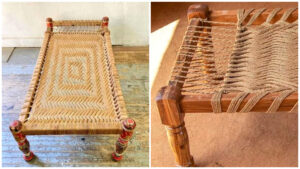
The humble charpoy, also known as khaat, manji, or traditional Indian cot, is a familiar sight across rural India. Found in village courtyards, dhabas, and ancestral homes, this woven wooden bed has been part of Indian living for generations.
But recently, this everyday piece of furniture has found itself on the catalogs of international home décor brands—rebranded as “handwoven daybeds,” “ethnic benches,” or “bohemian loungers,” and sold for prices that will surprise you.
What Is a Charpai?
The charpai is a four-legged, handwoven bed made with wooden or bamboo frames and interlaced with cotton, jute, or nylon ropes. It’s not just furniture—it’s a lifestyle. Used for sleeping, sitting, chatting, or even eating, it’s been a multifunctional staple in Indian homes for centuries.
In India, an average charpoy costs anywhere between ₹1,500 to ₹4,000, depending on the quality and craftsmanship.
How International Brands Are Selling It
Luxury furniture brands and online marketplaces in the West are now featuring Indian-style charpoys in their catalogues. For example:
Goodee or The Citizenry (US/Canada) list similar woven benches and daybeds as handcrafted bohemian furniture priced upwards of ₹60,000 to ₹1,50,000 ($700–$1,800).
Anthropologie or Urban Outfitters have sold similar versions labeled as “rustic woven daybeds” for $800+.
Etsy sellers from the US and UK showcase vintage Indian charpoys as collectible décor items, sometimes crossing ₹1 lakh+ in price.
These products often feature slightly modernized materials or finishes, but the essence remains distinctly Indian.
Cultural Design or Capitalist Spin?
This trend, while flattering to Indian design, raises several important questions:
Are these brands giving due credit to Indian artisans?
Are they collaborating with rural communities or simply capitalizing on age-old designs?
Is the cultural context of the charpoy being respected, or erased?
For many Indians, the charpoy is associated with nostalgia, simplicity, and rootedness—not something you’d expect to see tagged as “luxury rustic furniture.”
A Missed Opportunity or a New Platform?
This could have been an incredible opportunity for:
Artisan collaborations, ensuring traditional weavers and carpenters earn global recognition (and better income).
Sustainable storytelling, as charpoys are often made from eco-friendly materials.
Preserving dying crafts, by supporting local communities who still make charpoys the old-fashioned way.
Conclusion: From Indian Courtyards to Global Showrooms
The Indian charpoy’s rise on global platforms shows how traditional crafts are being rediscovered by the world. But with that comes a responsibility—to acknowledge the source, support the maker, and preserve the cultural soul of these creations.
A charpoy isn’t just furniture. It’s a piece of India.
END OF ARTICLE…!!


